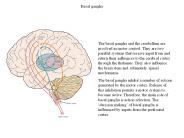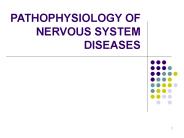Basal Ganglia Disease PowerPoint PPT Presentations
All Time
Recommended
Basal ganglia disease refers to a group of physical dysfunctions that occur when the group of nuclei in the brain known as the basal ganglia fail to properly initiate movements.
| PowerPoint PPT presentation | free to download
tremor, chorea (athetosis, ballism), myoclonus, tics, dystonia. Huntington's disease, Wilson's disease, essential tremor, focal and generalised dystonias ' ...
| PowerPoint PPT presentation | free to view
Basal Ganglia Involved in the control of movement Dysfunction associated with Parkinson s and Huntington s disease Site of surgical procedures -- Deep Brain ...
| PowerPoint PPT presentation | free to download
Basal ganglia The basal ganglia and the cerebellum may be viewed as key elements in two parallel reentrant systems that receive input from and return their influences ...
| PowerPoint PPT presentation | free to download
Mechanisms Underlying DBS Mysterious. Poorly understood: Which neurons DBS acts on. ... one explain improvement of PD symptoms if DBS increases GPi output ...
| PowerPoint PPT presentation | free to view
... provide the excitatory signals that balance out the large no. of the inhibitory signals transmitted specially by the dopamin, GABA & serotonin inhibitory ...
| PowerPoint PPT presentation | free to view
Basal Ganglia and Motor Control L21 Faisal I. Mohammed, MD, PhD
| PowerPoint PPT presentation | free to download
Motor Disease Alzheimer Disease
| PowerPoint PPT presentation | free to view
Functional Anatomy of the Basal Ganglia Sharif Taha, Ph.D. s.taha@utah.edu Department of Neurobiology and Anatomy ...
| PowerPoint PPT presentation | free to download
Basal ganglia disease refers to a group of physical dysfunctions that occur when the group of nuclei in the brain known as the basal ganglia fail to properly initiate movements.
| PowerPoint PPT presentation | free to download
Basal ganglia disease refers to a group of physical dysfunctions that occur when the group of nuclei in the brain known as the basal ganglia fail to properly initiate movements.
| PowerPoint PPT presentation | free to download
Title: PowerPoint Presentation Author: Shaikh Mujeeb Last modified by: Shaikh Mujeeb Created Date: 1/1/1601 12:00:00 AM Document presentation format
| PowerPoint PPT presentation | free to view
2D Gaussian kernel populations. Food location relative to mouth. Food location ... Striatum with TD error signal from midbrain dopaminergic system (SNc, VTA) ...
| PowerPoint PPT presentation | free to view
Parkinson's Disease. Huntington's Disease. 12. Basal Ganglia. rostral. striatum. putamen ... Huntington's Chorea (aka Huntington's Disease) 1872, George Huntington ...
| PowerPoint PPT presentation | free to view
Figure 2: Wilson disease. T2-weighted MR image depicts bilaterally symmetric areas of abnormal T2 hypersignal in the thalamus, putamina and caudate nuclei.
| PowerPoint PPT presentation | free to download
Wilson s Disease, A Disease to know Abdulwahab Telmesani FRCPC,FAAP Faculty of Medicine and Medical Science Umm Al-Qura University Wilson s Disease Liver biopsy ...
| PowerPoint PPT presentation | free to view
Brain, diffuse laminar necrosis and necrosis of basal ganglia. ... Multiple sclerosis. Multiple sclerosis. Multiple sclerosis plaque. Spinal cord section in ...
| PowerPoint PPT presentation | free to view
Pakarian P, Rayegani SM, and Shahzadi S. (2004) Effect of Vim ... in Ia fibres (which are the afferent fibers of stretch reflexes) results in tremor cessation. ...
| PowerPoint PPT presentation | free to download
Firing rates, patterns and oscillatory activity in basal ganglia in movement ... Propofol anesthesia decreases GPi firing rates and increases burstiness (BI) ...
| PowerPoint PPT presentation | free to view
A preliminary model for the role of the basal ganglia in natural motor control and motor programming MURI Meeting, June 4th, 2002 Steve Massaquoi, Zhi-Hong Mao ...
| PowerPoint PPT presentation | free to download
Cerebellum. BASAL GANGLIA. Cerebral Cortex. Parkinson's Disease ...
| PowerPoint PPT presentation | free to view
Parkinson’s disease (PD) is the second most common neurodegenerative disease after Alzheimer’s disease, affecting around 7.4 million people worldwide. It is caused by the progressive loss of dopamine-producing neurons in the substantia nigra within the basal ganglia.
| PowerPoint PPT presentation | free to download
If the basal ganglia are not working properly, as in Parkinson's disease ... of movement, stiffness and effort required to move a limb and, often, tremor. ...
| PowerPoint PPT presentation | free to download
Tremor. 5. Basal. ganglias. 6. Kayser-Fleischer ring. 7. 8. 9 'As the doctor says of a wasting disease, to start with it is easy to cure but ...
| PowerPoint PPT presentation | free to view
introduction to esophageal diseases
| PowerPoint PPT presentation | free to download
Big Market Research has announced a new Report Package "Global Huntington's Disease Therapeutics Market -Size, Share, Trends, Forecast, Development, Situation, Future outlook, Potential" Get Complete Details At: http://www.bigmarketresearch.com/global-huntingtons-disease-therapeutics-2014-2018-market Huntington's disease is a progressive neurodegenerative disorder that can be inherited from one generation to another as an autosomal dominant trait. It arises due to genetically programmed degeneration of neurons in some parts of the brain such as basal ganglia and cerebral cortex. Enquire At: http://www.bigmarketresearch.com/report-enquiry/144058
| PowerPoint PPT presentation | free to download
Parkinson's Disease. The basal ganglia, through the action of dopamine, are ... Dopamine levels in the brain's substantia nigra do normally fall with ageing. ...
| PowerPoint PPT presentation | free to download
Nervous System Pathology Lecture 3: Cerebrovascular Disease and Seizure Disorders Alvin V. Terry, Jr., Ph.D. Associate Professor UGA College of Pharmacy
| PowerPoint PPT presentation | free to view
Big Market Research has announced a new Report Package "Global Huntington's Disease Therapeutics Market -Size, Share, Trends, Forecast, Development, Situation, Future outlook, Potential" Get Complete Details At: http://www.bigmarketresearch.com/global-huntingtons-disease-therapeutics-2014-2018-market Huntington's disease is a progressive neurodegenerative disorder that can be inherited from one generation to another as an autosomal dominant trait. It arises due to genetically programmed degeneration of neurons in some parts of the brain such as basal ganglia and cerebral cortex. Enquire At: http://www.bigmarketresearch.com/report-enquiry/144058
| PowerPoint PPT presentation | free to download
Vesiculobullous Diseases
| PowerPoint PPT presentation | free to view
Moyamoya disease is a unique chronic progressive cerebrovascular disease ... ETIOLOGY. Unknown. Familial occurrence of approximately 10% of cases ...
| PowerPoint PPT presentation | free to view
basal ganglia (neurologic symptoms) Kayser-Fleischer green brown ring ... distended, friable, congested segment. perforation peritonitis ...
| PowerPoint PPT presentation | free to view
Title: Memory and learning Author: Michael Walker Last modified by: xp Created Date: 4/12/2005 4:36:56 AM Document presentation format: On-screen Show (4:3)
| PowerPoint PPT presentation | free to view
PARATHYROID GLAND DISEASES Primary hyperparathyroidism Hypoparathyroidism
| PowerPoint PPT presentation | free to view
PARATHYROID GLAND DISEASES Primary hyperparathyroidism Hypoparathyroidism
| PowerPoint PPT presentation | free to view
Cerevrovascular disease Dr. Basu MD Topic Cerebral (intracranial) hemorrhage Types Etiology Morphology Clinical features Intracranial hemorrhage: types Non traumatic ...
| PowerPoint PPT presentation | free to download
Neurodegenerative Diseases Gerianne R. Bliss, M.D. Chuck Hensley, R.Ph. Parkinson s Disease Resting tremor, rigidity, and bradykinesia Degeneration of dopaminergic ...
| PowerPoint PPT presentation | free to view
Multiple Sclerosis. Alzheimer's Disease. Creutzfeld-Jakob Disease. Seizure Disorders (Epilepsy) ... Multiple sclerosis. Scarred hardening (sclerosis) of myelin ...
| PowerPoint PPT presentation | free to view
Trisomy 21 (Down syndrome) most frequent - 1:700 births; parents have normal karyotype ... Trisomy 18 (Edwards syndrome) 1:8000. Trisomy 13 (Patau syndrome) 1:15000 ...
| PowerPoint PPT presentation | free to view
pathophysiology of nervous system diseases*
| PowerPoint PPT presentation | free to download
100's of DNA markers mapped onto each chromosome. high density linkage map. ... Mapped gene to end of chromosome 4 using RFLPs and other polymorphic. DNA ...
| PowerPoint PPT presentation | free to view
Patients usually unaware of rigidity but troubled with slowness ... Patient leans to affected side. Stage 1.5. One sided disease plus axial (waist) involvement ...
| PowerPoint PPT presentation | free to view
... designer drugs, repeated head injuries sustained from boxing and brain tumors ... Caffeine consumers who consume 5 cups per day. Management ...
| PowerPoint PPT presentation | free to view
Destruction of dopaminergic neurons in the pars compacta of the ... Increases intracellular iron that can. catalyze reactions to produce toxic-free radicals ...
| PowerPoint PPT presentation | free to view
The development of transgenic models, has been intensively used for ... If neurons are deprived of oxygen and the ATP stores drop, excess excitatory ...
| PowerPoint PPT presentation | free to download
Cytopathology A branch of pathology that deals with manifestations of disease ... BDNF's are pro-survival factors produced by the cortical neurons of the brain. ...
| PowerPoint PPT presentation | free to view
In 2000, 7 percent of those with AD were age 65-74, 53 percent ... Distinction between palliative and preventative. Current treatment is Donepezil (Aricept) ...
| PowerPoint PPT presentation | free to view
Exceeded only by Heart disease and Cancer ... condition in which a restricted neurological deficit spreads relentlessly over a ...
| PowerPoint PPT presentation | free to view
... anti-microsomal antibodies Multiple sclerosis anti ... pH of body fluids gastric acid acid pH of 2 in ... Mono clonal also applies to a class ...
| PowerPoint PPT presentation | free to view
akinesia. posture & balance are disturbed - stooped gait. mask like facial ... reducing the effects of akinesia in distal movement (e.g. movement of the limbs) ...
| PowerPoint PPT presentation | free to view
parkinson disease update harvey a. drapkin, d.o., facn 1817 described by james parkinson six cardinal features rest tremor rigidity flexed posture bradykinesia ...
| PowerPoint PPT presentation | free to view
TO DIAGNOSE: TWO OF ABOVE, WITH AT LEAST ONE BEING REST TREMOR OR BRADYKINESIA ... IDENTIFICATION OF PRE-CLINICAL DISEASE STATE AND BIOMARKER IS A PRIORITY OF ...
| PowerPoint PPT presentation | free to view
Progressive supranuclear palsy: oculomotor dysfunction (impaired vertical eye ... of pharyngeal muscles (pseudobulbar palsy); early falls; axial rigidity (neck ...
| PowerPoint PPT presentation | free to view
Rehabilitation Management of Parkinsons Disease Susan Stickevers, MD Residency Program Director & Assistant Clinical Professor, SUNY Stony Brook Dept of PM&R
| PowerPoint PPT presentation | free to download
Dysphagia. Common in advanced disease. Slowness in propelling food to pharynx ... Dysphagia. Watch for aspiration. Barium swallow cine-esophagram ...
| PowerPoint PPT presentation | free to view
Title: PowerPoint Presentation Author: VCROWLEY Last modified by: vcrowley Created Date: 6/20/2004 1:11:10 PM Document presentation format: On-screen Show
| PowerPoint PPT presentation | free to view
























































